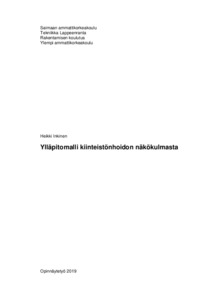Ylläpitomalli kiinteistönhoidon näkökulmasta
Inkinen, Heikki (2019)
Inkinen, Heikki
2019
All rights reserved. This publication is copyrighted. You may download, display and print it for Your own personal use. Commercial use is prohibited.
Julkaisun pysyvä osoite on
https://urn.fi/URN:NBN:fi:amk-2019121025855
https://urn.fi/URN:NBN:fi:amk-2019121025855
Tiivistelmä
Tämä tutkimus tehtiin YIT Suomi Oy:n tarpeesta löytää käyttöä tietomalleille ylläpidossa. Teoreettisena viitekehyksenä käytettiin alan kirjallisuutta. Ajankohtaisuutensa vuoksi lähteissä havaittiin eroavaisuuksia riippuen julkaisuajankohdasta. Tästä syystä teoriaa täydennettiin haastatteluilla. Empiirisen tutkimuksen tuloksena tämä tutkimus kehittää ylläpitomallien teoriaa.
Työn tavoitteena oli saada tilaajayritykselle ylläpitomalli käyttöön. Tutkimuksessa havaittiin kuitenkin kriittisiä kehitysaskeleita, jotka estävät suoran ylläpitomallien käytön. Työssä on annettu ohjeistus, kuinka tilaajayritys voi päästä tavoitteeseen. Lisäksi tässä työssä on annettu ehdotus, kuinka testata ylläpitomalleja ilman investointeja työkaluihin.
Ylläpitomallit ovat Suomessa melko tuore käsite, mutta muualla maailmassa jo tuttu käsite myös valmiiden prosessien osalta. Esimerkiksi Singaporessa asiasta on annettu jo valtiontasoinen ohjeistus.
Ylläpitomalli on lyhyesti tietomallipohjainen ohjelma-alusta, joka yhdistää normaalit ylläpitoprosessit ja -ohjelmat. Nämä ovat esimerkiksi sähköinen huoltokirja, projektipankki, pitkän tähtäimen suunnittelu ja budjetointi.
Kehitysideaksi tässä työssä todettiin todenmukainen toteumamallin saavuttaminen, ylläpito-ohjelmien integrointi ja hyperlinkitetty tietomalli. The purpose of the research was to find usage to building information models created during investment phase for facility management. The study was commissioned by YIT Finland Ltd.
Data for this research were collected from literature on the subject. In addition to literature more information about the subject was carried by interviews of companies specialized in facility management consultation and IT-service. These sources combined creates the theory and basis of study. Empirical part of the research was created by interviewing people working in facility management and YIT. Empirical part was compared to theoretical part creating results and developing existing theories.
The results of the study show that usage of building information models in facility management is at its beginning. A few critical processes must be developed before usage of BIM in FM can be effective. These processes are real-time data collection development, integration of facility management programs and as-built building information models. Based on findings BIM in FM is basically a three-dimensional platform of the building that integrates facility management programs such as electronic service book, budgeting, data storage and long-term planning. In cost effectiveness it is studied that cumulative usage of BIM in FM can reduce costs of service providers by 3-6% due to exact information of the building. It was also found that cumulative usage of BIM in FM can reduce used time by 8,7% in service tasks.
Once processes have been developed enough evolutionary step would be linking BIM to data storage servers. This can be created without investing in new tools and can be created by anyone who has skills to use BIM programs. Further study is required to be done as case-study for YIT in usage of BIM in FM. At the moment it cannot be done in cost effective way.
The abstract should be no longer than 200 words and it should have three paragraphs. The first about the purpose and commissioner, the second about methods and material and the third about results and recommendations.
Työn tavoitteena oli saada tilaajayritykselle ylläpitomalli käyttöön. Tutkimuksessa havaittiin kuitenkin kriittisiä kehitysaskeleita, jotka estävät suoran ylläpitomallien käytön. Työssä on annettu ohjeistus, kuinka tilaajayritys voi päästä tavoitteeseen. Lisäksi tässä työssä on annettu ehdotus, kuinka testata ylläpitomalleja ilman investointeja työkaluihin.
Ylläpitomallit ovat Suomessa melko tuore käsite, mutta muualla maailmassa jo tuttu käsite myös valmiiden prosessien osalta. Esimerkiksi Singaporessa asiasta on annettu jo valtiontasoinen ohjeistus.
Ylläpitomalli on lyhyesti tietomallipohjainen ohjelma-alusta, joka yhdistää normaalit ylläpitoprosessit ja -ohjelmat. Nämä ovat esimerkiksi sähköinen huoltokirja, projektipankki, pitkän tähtäimen suunnittelu ja budjetointi.
Kehitysideaksi tässä työssä todettiin todenmukainen toteumamallin saavuttaminen, ylläpito-ohjelmien integrointi ja hyperlinkitetty tietomalli.
Data for this research were collected from literature on the subject. In addition to literature more information about the subject was carried by interviews of companies specialized in facility management consultation and IT-service. These sources combined creates the theory and basis of study. Empirical part of the research was created by interviewing people working in facility management and YIT. Empirical part was compared to theoretical part creating results and developing existing theories.
The results of the study show that usage of building information models in facility management is at its beginning. A few critical processes must be developed before usage of BIM in FM can be effective. These processes are real-time data collection development, integration of facility management programs and as-built building information models. Based on findings BIM in FM is basically a three-dimensional platform of the building that integrates facility management programs such as electronic service book, budgeting, data storage and long-term planning. In cost effectiveness it is studied that cumulative usage of BIM in FM can reduce costs of service providers by 3-6% due to exact information of the building. It was also found that cumulative usage of BIM in FM can reduce used time by 8,7% in service tasks.
Once processes have been developed enough evolutionary step would be linking BIM to data storage servers. This can be created without investing in new tools and can be created by anyone who has skills to use BIM programs. Further study is required to be done as case-study for YIT in usage of BIM in FM. At the moment it cannot be done in cost effective way.
The abstract should be no longer than 200 words and it should have three paragraphs. The first about the purpose and commissioner, the second about methods and material and the third about results and recommendations.
